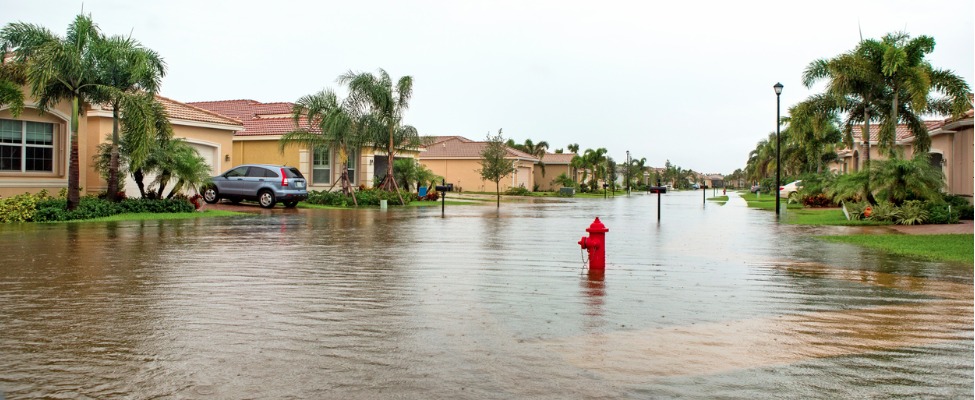After the Flood: Outdoor Clean Up

As people begin to recover from flooding like that of Hurricane Harvey and Irma, indoor clean up is usually the first priority. However, floodwater can damage your yard more than just cosmetically. Floodwater contains sewage, gasoline, and other potentially harmful substances. Whether you have natural or synthetic grass, smells, mold and other contaminants need to be dealt with so you can continue to enjoy your outside spaces.
Protecting Yourself from Mold and Black Water
Assume the worst about what was in the water, and protect yourself with non-latex gloves, rubber boots, long sleeves and pants. While you're cleaning, be sure to wear goggles to protect your eyes from mold spores, dust, and splinters.
If mold is present, it is very important to wear an N95 respirator mask, which can be purchased at hardware stores. The Center for Disease Control warns, "In 2004 the Institute of Medicine (IOM) found there was sufficient evidence to link indoor exposure to mold with upper respiratory tract symptoms, cough, and wheeze in otherwise healthy people; with asthma symptoms in people with asthma; and with hypersensitivity pneumonitis in individuals susceptible to that immune-mediated condition." For these reasons, children, the elderly, and those with asthma should not participate in the clean up.
When you leave the site, be sure to change into a fresh set of clothes and shower if possible.
Dealing with Outdoor Odors & Mold
One of the problems after a flood is simply the smell from sewage and rotting plants. Harmful pathogens, including bacteria and mold, can be tracked into the house if not dealt with.
While it is impossible to completely sanitize dirt, Wysiwash is a great tool for getting rid of odors outside. Wysiwash is biodegradable and can safely be sprayed on or near plants, patios, and other outside surfaces to sanitize
Sunlight prevents much outdoor mold growth, but it can develop in shady areas or areas that did not fully dry out. Wysiwash can also be used on siding, decks, and fencing to prevent mold growth and remove dirt that the flood caked on. We recommend doing this on a sunny day so that the surfaces can dry.
If there is mold that you can see, we recommend using Wysiwash daily until the mold is no longer visible. Then decrease the frequency, but continue applying Wysiwash to prevent regrowth. Follow our guidelines for cleaning mold.
Tips for Cleaning and Restoring Synthetic Grass After a Flood
There are several concerns after synthetic grass has been flooded due to a natural disaster. Debris, sediment, and infill depletion can reduce the longevity of your turf, or in the case of mold turn your yard into a biohazard.
We recommend having your installer come assess the damage. They can look at whether the drainage system has been damaged, and do testing for mold and chemical contaminants. An assessment may also be necessary to keep your turf under warranty.
For Sediment or Silt on Top of Carpet
Fast moving floodwater often leaves a layer of sediment or silt on artificial turf. As soon as floodwaters recede, Wysiwash can be used to remove the sediment, disinfect, and prevent mold in one step.
It sounds crazy to add water to recently flooded lands, but that is your best chance at preventing long term damage for to your artificial turf.
Spray Wysiwash until the turf is flooded. Try to keep the sediment suspended and direct it towards draining areas so it doesn't settle back into the turf fibers or infill.
It sounds crazy to add water to recently flooded lands, but that is your best chance at preventing long term damage to your artificial turf.
For Infill Restoration
Check your infill levels. It is likely that the floodwater washed some of the infill away, experts recommend looking for it in the lowest lying part of your yard. Depending on how much has been washed away, you may want to replenish or replace the infill.
Wrinkled turf carpet is also a sign that the infill has been washed away.
Signs that Artificial Turf Needs to Be Replaced
An assessment that from a professional will help you determine if the turf needs to be replaced. Some potential reasons for complete replacement are:
- Significant amounts of oil have collected on the turf.
- The carpet or infill have been washed away completely.
- The drainage systems have been damaged.
Adapt these tips to your situation, keeping safety at the forefront of your mind.
If you want more information about Wysiwash, watch this quick video.
